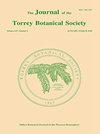纽约中央公园的自发维管植物区系
IF 0.8
4区 生物学
Q4 PLANT SCIENCES
引用次数: 4
摘要
这项工作详细介绍了2013年至2017年期间纽约市中央公园的自发维管植物区系。我们将341公顷(843英亩)的公园划分为36个区域,并使用改进的定时蜿蜒取样方法收集植物标本馆标本和硅干标本(用于DNA分析)。我们收集每一个新物种,直到我们不再发现任何以前在任何地区没有遇到过的物种。共采集标本1468份,分属89科262属438种和2个亚特异分类群。结果表明,其中45%为本地植物(198种),54%为非本地植物(240种)。3种原生状态未知(<1%)。最大的科是禾本科(56种)、菊科(55种)、蔷薇科(27种)、豆科(20种)和蓼科(17种)。最大的属是桃属(8种)、苔属(7种)、槭属(7种)、莎草属(6种)、红草属(6种)和绿草属(6种)。纽约自然遗产计划将7种列为稀有、受威胁或濒危物种。36种物种被纽约州列为禁止或管制的入侵物种。本研究在中央公园收集了4种纽约州新物种。自2007年最后一次清点以来,我们又记录了76个物种。自2007年以来,本地物种的比例增加了5%。数据表明,集中于控制入侵物种和种植和支持本地物种的管理工作是有效的。自发的、归化的植物群列在附录1中。自发的植物出现一次或偶尔出现,但如果不反复引入就不能持续存在,则列在附录2中。以科学名称和常用名称、纽约州的本地状态、保守性系数、纽约自然遗产计划稀有度排名(S1-S5)、在中央公园观察到的频率(罕见、不常见和频繁)以及在中央公园观察到的物种繁殖力(减少、稳定或增加)列出。所有报告的物种均由纽约植物园的植物标本馆标本和硅干组织样本证明。本文章由计算机程序翻译,如有差异,请以英文原文为准。
The Spontaneous Vascular Plant Flora of New York's Central Park11b
This work details the spontaneous vascular plant flora of New York City's Central Park for the period 2013 to 2017. We divided the 341-ha (843-acre) park into 36 zones and used a modified timed-meander sampling method to collect herbarium specimens and silica-dried samples (for DNA analysis) of spontaneous, naturalized plants. We collected each new species until we ceased to find any species that had not been previously encountered in any zone. We collected 1,468 specimens, representing 438 species and two subspecific taxa from 262 genera and 89 families, and a number of cultivated species not analyzed is this work. We find that 45% of the flora are native (198 species) and 54% (240 species) are nonnative. Three species are of unknown native status (<1%). The largest families are Poaceae (56 species), Asteraceae (55), Rosaceae (27), Fabaceae (20), and Polygonaceae (17). The largest genera are Persicaria (8 species), Carex (7), Acer (7), Cyperus (6), Rubus (6), and Eragrostis (6). Seven species are ranked as rare, threatened, or endangered by New York Natural Heritage Program. Thirty-six species are listed as prohibited or regulated invasive species by New York State. Four species new for New York State were collected in Central Park during this study. We documented 76 additional species since the last inventory of 2007. The percentage of native species has increased by 5% since 2007. The data suggest that management efforts focused on controlling invasive species and planting and supporting native species have been effective. The spontaneous, naturalized flora is listed in Appendix I. Spontaneous plants that appear once or sporadically but do not persist without repeated introduction are listed as waifs in Appendix II. The species are listed with scientific and common name, native status in New York State, coefficient of conservatism, New York Natural Heritage Program rarity ranking (S1–S5), observed frequency in Central Park (rare, infrequent, and frequent), and observed species fecundity for Central Park (decreasing, stable, or increasing). All species reported are vouchered by herbarium specimens and silica-dried tissue samples at the New York Botanical Garden.
求助全文
通过发布文献求助,成功后即可免费获取论文全文。
去求助
来源期刊
CiteScore
0.70
自引率
0.00%
发文量
16
审稿时长
>12 weeks
期刊介绍:
The Journal of the Torrey Botanical Society (until 1997 the Bulletin of the Torrey Botanical Club), the oldest botanical journal in the Americas, has as its primary goal the dissemination of scientific knowledge about plants (including thallopyhtes and fungi). It publishes basic research in all areas of plant biology, except horticulture, with an emphasis on research done in, and about plants of, the Western Hemisphere.

 求助内容:
求助内容: 应助结果提醒方式:
应助结果提醒方式:


